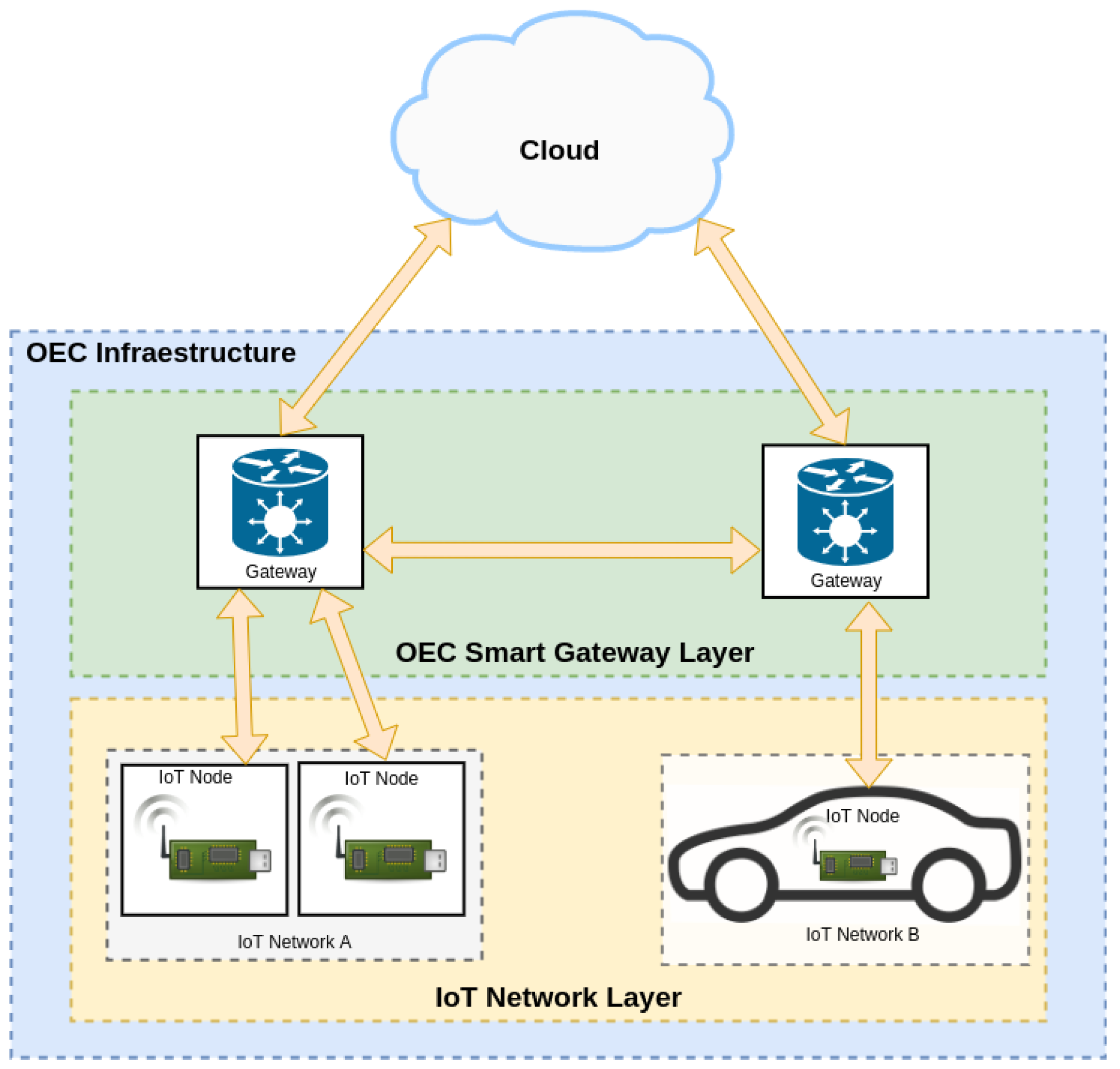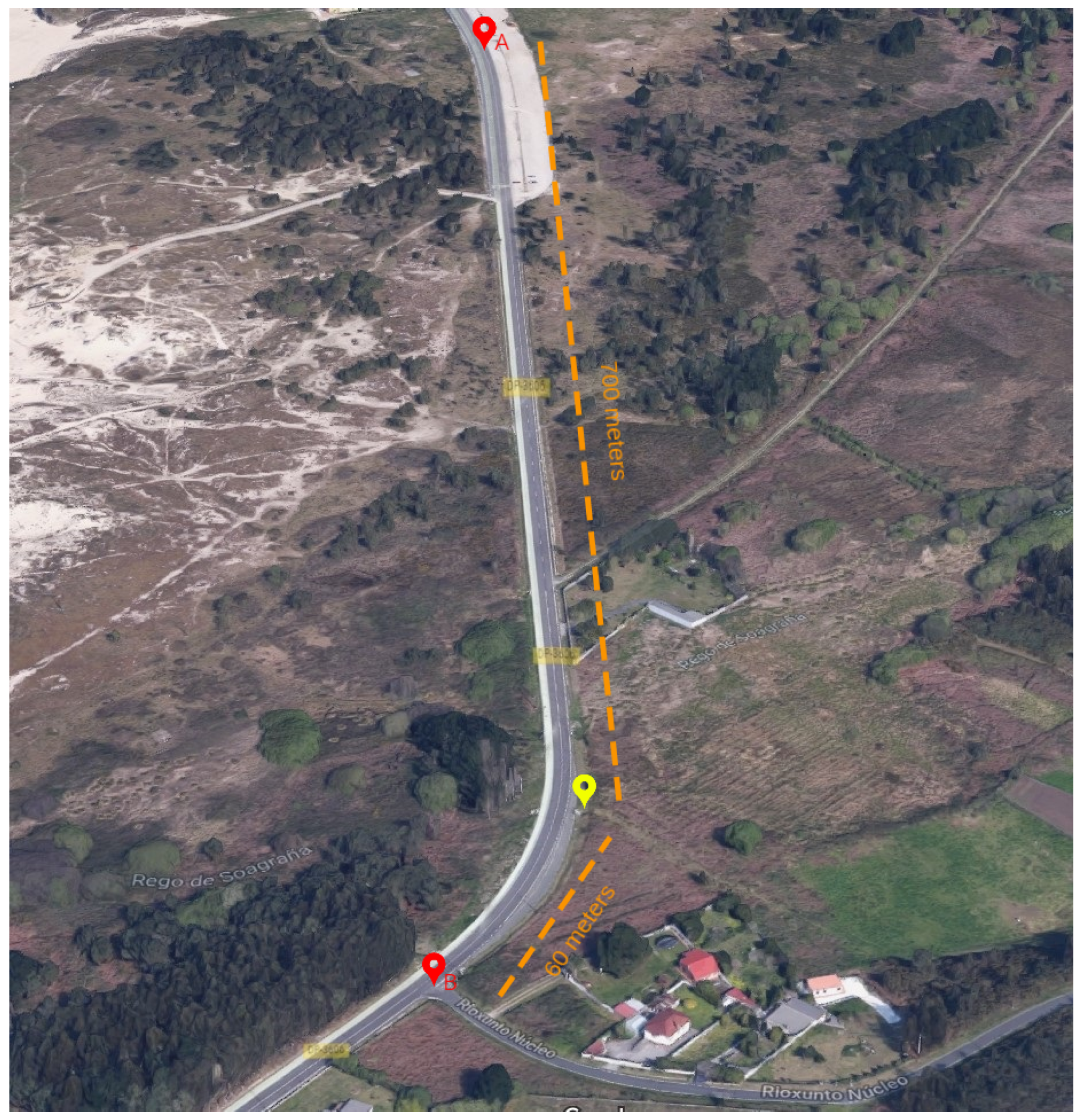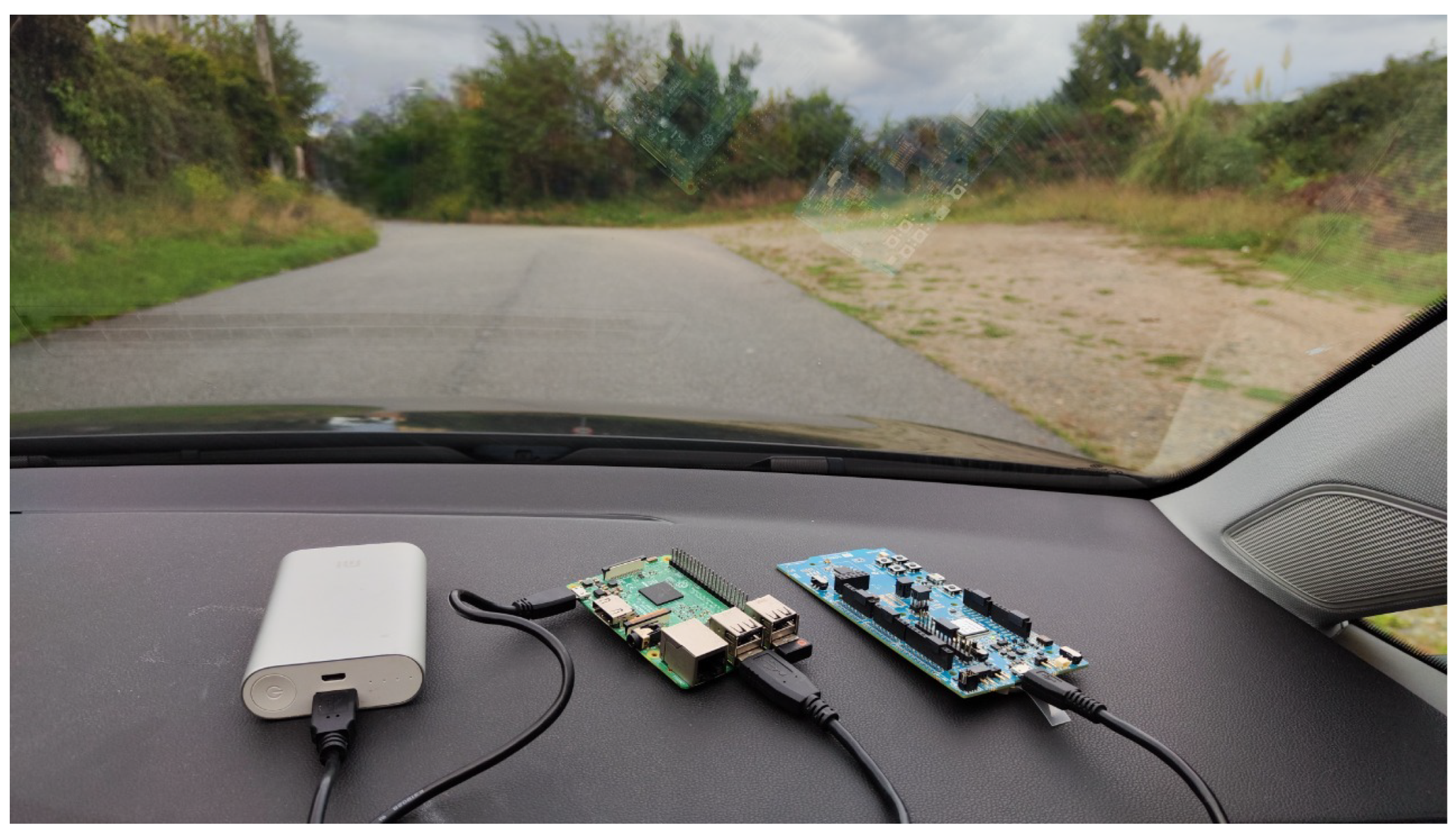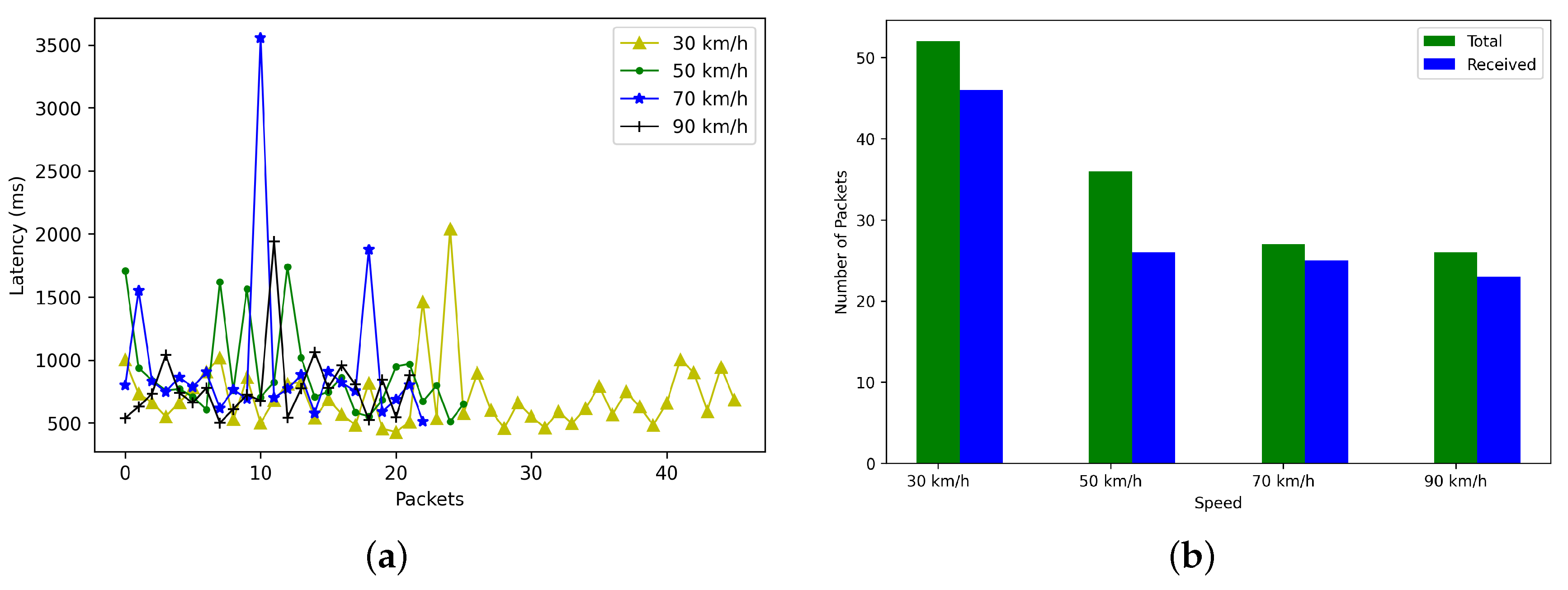A Bluetooth 5 Opportunistic Edge Computing System for Vehicular Scenarios †
Abstract
1. Introduction
2. State of the Art: Opportunist Mobile Edge Computing Systems
- The usage of mobile fog computing enables the provision of edge computing services, thus reducing the time response to IoT nodes via low-cost gateways dispersed throughout large environments to provide opportunistic communications.
- The use of Bluetooth 5 enables mobile data exchanges with a greater range and less energy consumption than other technologies, such as WiFi, GSM or 4G/5G. In addition, Bluetooth 5 does not impose any mobility or transmission constraints, unlike other technologies such as LoRa, which is limited in terms of transmission speed and packets per time unit.
- The proposed architecture has been designed to be simultaneously decentralized, distributed, scalable and modular.
- The designed architecture also incorporates additional features such as resource sharing, data routing and IoT node discovery.
3. Design and Implementation of the System
3.1. Communications Architecture
- The IoT Network Layer. This layer consists of the several IoT networks that make up the system (IoT networks A and B in Figure 1), whose devices can exchange data with the higher layers. As a result, IoT nodes utilize sensors and actuators to monitor and interact with their surroundings. Such nodes can be either static (i.e., the ones represented in IoT Network A in Figure 1) or mobile (i.e., the node that belongs to IoT Network B in Figure 1). In any case, the nodes exchange information with the opportunistic layer, which provides them with multiple edge computing services. What distinguishes the IoT Network Layer from others present in generic IoT architectures is the fact that communications with the upper layer are not always available, so they need to be carried out in an opportunistic way (i.e., IoT devices need to discover when the upper layer devices are available to make use of its services).
- The OEC Smart Gateway layer. This layer is made up of fog computing gateways that may supply services opportunistically to the IoT Network Layer. Such services are characterized by having lower latency than the ones provided by a remote cloud on the internet due to the physical proximity of the gateway to the IoT nodes. Moreover, in the proposed OEC architecture, the data from the IoT devices are stored in a distributed hash table (DHT) network shared by the gateways.
- The Cloud layer. This layer is in charge of providing services that the OEC smart gateways cannot deliver, such as compute-intensive processing or large-scale data storage.
3.2. Implementation
- Peer discovery and peer routing. Peer discovery allows for discovering peer addresses thanks to the knowledge provided by the other peers. The peer routing subsystem exposes an interface to identify the peers to which the message should be routed. The protocol used was Kademlia DHT [11], which is based on DHTs.
- Data routing. Data routing uses mechanisms to forward messages to peers if the receiving peer is not within range of the sending peer. Kademlia DHT was also used for implementing this feature.
4. Experiments
4.1. Experimental Setup
- The data were first sent by using Bluetooth 5 (BLE) from the static IoT node to the smart OEC gateway located locally in the office. The gateway and the static IoT node were separated by roughly one meter and had a direct line of sight (LoS). Both devices were connected through WiFi and used an optic fiber router to connect the Internet to the cloud.
- Then, the indoor gateway received the data from the static IoT node through its serial port (to which a Bluetooth 5 development kit was attached) and uploaded them to the DHT network.
- Next, the OEC gateway that operated outdoors in the same opportunistic network in which the mobile node was located, collected the data sent through the DHT network. The outdoor gateway was located on a straight road (shown in Figure 2) and at a height of approximately 1.80 m. To make the communication between the indoor and outdoor gateways possible, it was necessary for the cloud to act as a relay. For the tests performed in this article, the cloud was located in a remote server whose ping was about 50 ms when using the fiber optic router of the office and roughly 150 ms for the 4G smartphone carried in the car.
- Finally, the outdoor gateway sent the message to the mobile IoT node through Bluetooth 5 (using BLE). The mobile node was carried inside a car as shown in Figure 3. The car was driven at different constant speeds between points A and B indicated in Figure 2 (the itinerary started at point A, reached point B and returned to point A). It must be noted that, before beginning this set of experiments, it was verified that 100% of the packets were received at the vehicular IoT node when it was static in point A inside the vehicle. After this verification, tests were performed at four vehicular speeds (at 30, 50, 70 and 90 km/h) while evaluating the packet reception loss and end-to-end latency.
4.2. Obtained Results
5. Conclusions
Author Contributions
Funding
Institutional Review Board Statement
Informed Consent Statement
Data Availability Statement
Conflicts of Interest
References
- HIS. Internet of Things (IoT) Connected Devices Installed Base Worldwide from 2015 to 2025. Available online: https://bit.ly/3n6aQDO (accessed on 13 September 2022). (In Billions).
- Gubbi, J.; Buyya, R.; Marusic, S.; Palaniswami, M. Internet of Things (IoT): A vision, architectural elements, and future directions. Future Gener. Comput. Syst. 2013, 29, 1645–1660. [Google Scholar] [CrossRef]
- Kshetri, N. Can Blockchain Strengthen the Internet of Things? IT Prof. 2017, 19, 68–72. [Google Scholar] [CrossRef]
- Fraga-Lamas, P.; Lopes, S.I.; Fernández-Caramés, T.M. Green IoT and Edge AI as Key Technological Enablers for a Sustainable Digital Transition towards a Smart Circular Economy: An Industry 5.0 Use Case. Sensors 2021, 21, 5745. [Google Scholar] [CrossRef] [PubMed]
- Froiz-Míguez, I.; Lopez-Iturri, P.; Fraga-Lamas, P.; Celaya-Echarri, M.; Blanco-Novoa, Ó.; Azpilicueta, L.; Falcone, F.; Fernández-Caramés, T.M. Design, Implementation, and Empirical Validation of an IoT Smart Irrigation System for Fog Computing Applications Based on LoRa and LoRaWAN Sensor Nodes. Sensors 2020, 20, 6865. [Google Scholar] [CrossRef] [PubMed]
- Habib ur Rehman, M.; Batool, A.; Salah, K. The Rise of Proximal Mobile Edge Servers. IT Prof. 2019, 21, 26–32. [Google Scholar] [CrossRef]
- Mohamed, N.; Al-Jaroodi, J.; Jawhar, I.; Noura, H.; Mahmoud, S. UAVFog: A UAV-based fog computing for Internet of Things. In Proceedings of the 2017 IEEE SmartWorld, Ubiquitous Intelligence & Computing, Advanced & Trusted Computed, Scalable Computing & Communications, Cloud & Big Data Computing, Internet of People and Smart City Innovation (SmartWorld/SCALCOM/UIC/ATC/CBDCom/IOP/SCI), San Francisco, CA, USA, 4–8 August 2017; pp. 1–8. [Google Scholar]
- Alliance, A. Alljoyn Framework, Linux Found. Collaborative Projects. Available online: https://openconnectivity.org/technology/reference-implementation/alljoyn/ (accessed on 13 September 2022).
- Guidi, B.; Michienzi, A.; Ricci, L. A libP2P Implementation of the Bitcoin Block Exchange Protocol. In Proceedings of the 2nd International Workshop on Distributed Infrastructure for Common Good (DICG’21), Virtual, 6–10 December 2021; pp. 1–4. [Google Scholar]
- IPFS. The Interplanetary File System (IPFS). Available online: https://ipfs.io/ (accessed on 13 September 2022).
- Maymounkov, P.; Mazières, D. Kademlia: A Peer-to-Peer Information System Based on the XOR Metric. In Peer-to-Peer Systems. IPTPS 2002. Lecture Notes in Computer Science; Druschel, P., Kaashoek, F., Rowstron, A., Eds.; Springer: Berlin/Heidelberg, Germany, 2002; Volume 2429. [Google Scholar]
- Official Gitlab Repository of the ORBALLO Project. Available online: https://gitlab.com/orballo_project/opportunistic-ble-mesh (accessed on 13 September 2022).




Publisher’s Note: MDPI stays neutral with regard to jurisdictional claims in published maps and institutional affiliations. |
© 2022 by the authors. Licensee MDPI, Basel, Switzerland. This article is an open access article distributed under the terms and conditions of the Creative Commons Attribution (CC BY) license (https://creativecommons.org/licenses/by/4.0/).
Share and Cite
Niebla-Montero, Á.; Froiz-Míguez, I.; Fraga-Lamas, P.; Fernández-Caramés, T.M. A Bluetooth 5 Opportunistic Edge Computing System for Vehicular Scenarios. Eng. Proc. 2022, 27, 66. https://doi.org/10.3390/ecsa-9-13214
Niebla-Montero Á, Froiz-Míguez I, Fraga-Lamas P, Fernández-Caramés TM. A Bluetooth 5 Opportunistic Edge Computing System for Vehicular Scenarios. Engineering Proceedings. 2022; 27(1):66. https://doi.org/10.3390/ecsa-9-13214
Chicago/Turabian StyleNiebla-Montero, Ángel, Iván Froiz-Míguez, Paula Fraga-Lamas, and Tiago M. Fernández-Caramés. 2022. "A Bluetooth 5 Opportunistic Edge Computing System for Vehicular Scenarios" Engineering Proceedings 27, no. 1: 66. https://doi.org/10.3390/ecsa-9-13214
APA StyleNiebla-Montero, Á., Froiz-Míguez, I., Fraga-Lamas, P., & Fernández-Caramés, T. M. (2022). A Bluetooth 5 Opportunistic Edge Computing System for Vehicular Scenarios. Engineering Proceedings, 27(1), 66. https://doi.org/10.3390/ecsa-9-13214






